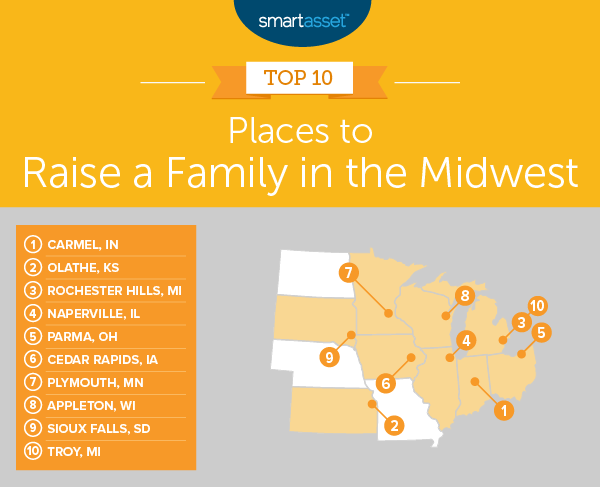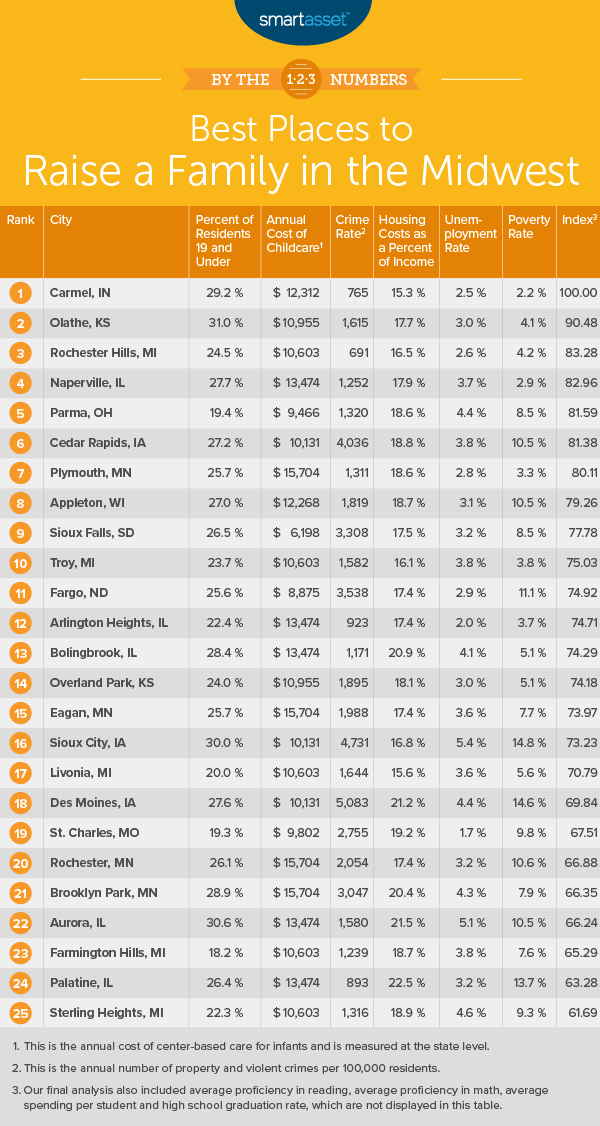If you’re looking to raise a family, the city you call home can affect many parts of your life. It potentially impacts the jobs available to you, how much you earn, how much it costs to live comfortably and how easy it is to build savings. Other factors like local schools and population also play a large role. We at SmartAsset understand that choosing where you and your family live is a big decision, and that’s why we created this list. Using data across 12 states in 10 metrics, we ventured to find the best places in the Midwest to raise a family.
To find the best cities to raise a family in the Midwest, we considered data on 10 factors. We looked at housing costs as a percent of income, the annual cost of childcare, the percent of residents under the age 20, average math and reading proficiencies, high school graduation rates, the average spending per pupil, poverty rates, unemployment rates and crime rates. You can learn more about our data sources and how we created the final ranking in the Data and Methodology section below.
Key Findings
- No single state dominates. Sometimes, we find that cities in a single state dominate the rankings in our studies. However, there seem to be great cities to raise a family spread across the Midwest. The cities in this top 10 represent nine different states.
- High incomes and affordable housing. For the top 10 cities in our study, households pay an average of 17.58% of their income on housing. This is well below the maximum 30% of your monthly budget that the Census Bureau recommends paying on housing. All 10 cities rank in the top 25 for that metric. Notably, cities in the top 10 also earn a lot. The average household income across those cities is $84,127.

1. Carmel, IN
Not only is Carmel, Indiana No. 1 on our list, but it also has a sizable lead over the second-place city. It scores well in nearly every metric and ranks in the top 10 for six out of the 10 metrics. Housing costs here make up just 15.35% of the median income, which is the best rate in our study. Similarly, Carmel has the lowest poverty rate at 2.20%. Unemployment is just 2.50%, which is fourth best. Looking at education-related metrics, the city ranks seventh for both its high reading proficiency as well as its graduation rate of 90.85%. The rate of property and violent crime in Carmel is also second-lowest in the study.
2. Olathe, KS
Olathe, Kansas is an affordable place to live. Annual housing costs make up less than 18% of the annual income. That’s a top-15 score. Those looking for a job will appreciate that the city has another top-15 score for its low unemployment. And for families seeking good schools, it’s nice to see that the high school graduation rate of 89.47% is a top-20 score for the Midwest region. There are also plenty of other children in Olathe. Nearly one third (31%) of the population is under the age of 20. People aren’t necessarily leaving when they reach their 20s, though. Olathe is also the top city where millennials are buying homes.
3. Rochester Hills, MI
Rochester Hills, Michigan is a good place for workers, with an unemployment rate of just 2.60%. That’s the sixth-best rate of all the cities we considered. The city is also affordable with the fifth-lowest rate of housing costs as a percentage of income (16.52%). Rochester Hills has the lowest crime rate of the 93 cities in this study. Its high school graduation rate, however, ranks in the bottom 25.
4. Naperville, IL
Naperville, Illinois is one of the safest cities in the entire country. While its scores for reading proficiency and math proficiency both rank in the bottom 25, the city spends more per pupil than any other place in our study. Living in Naperville is also relatively affordable. Annual housing costs account for less than 18% of the median income.
5. Parma, OH
Parma, Ohio has the fifth-lowest childcare costs in the region, at $9,466 annually. This metric looks at the full-time center-based childcare for infants. The affordability also extends to Parma housing costs, which include things like property taxes and homeowners insurance. Housing costs make up 18.60% of the median income. That’s a top-20 score. As children get older, they can look forward to furthering their studies here: The high school graduation rate in Parma is approximately 89%. Parma ranks in the top third for that rate, as well as for its rates for math and reading proficiencies.
6. Cedar Rapids, IA
Across Cedar Rapids, Iowa, approximately 76% of students are proficient in math and approximately 74% are proficient in reading. Both of those rates are the third-highest in the study. The city’s high school graduation rate of 88.85% is in the top third of all cities in this study. Furthermore, housing costs account for 18.76% of incomes. A top-25 rate, this adds to the affordability factor of Cedar Rapids. Annual childcare costs are also relatively low and rank in the top 25.
7. Plymouth, MN
Plymouth, Minnesota has a top-25 score for its spending per pupil, at more than $13,000 per year. The city’s students also rank in the top 25 for both reading and math proficiency. Plymouth has the ninth-lowest crime rate in the Midwest. Notably, the city also has top-10 scores for its low unemployment (2.80%) and poverty rates (3.30%).
8. Appleton, WI
At 91.96%, Appleton, Wisconsin has the third-highest high school graduation rate in our study. People looking to raise a family here will also appreciate that the city has one of the 20-lowest rates for property and violent crime. Naturally, affordability is also an important part of choosing where to raise your family. Appleton has a top-25 score for its housing costs as a percentage of income. Annual housing costs make up 18.67% of annual incomes. That low rate is great for families who are trying to stick to a budget.
9. Sioux Falls, SD
Sioux Falls, South Dakota stands out since it’s tied for the lowest childcare costs in the region. The annual cost of full-time center-based childcare for infants is less than $6,200. Sioux Falls also has the 12th-lowest housing costs as a percentage of income. Annual housing costs make up just 17.54% of the median annual income. As a reference, the Census Bureau recommends that you spend a maximum of 30% of your budget on housing. This means that most Sioux Falls residents can expect to pay far less than that. Even though the city’s high school graduation rate is relatively lower than that of other cities in this study, it’s also worth mentioning that we’ve previously found Sioux Falls to be the best city for young professionals.
10. Troy, MI
One of the standout factors that makes Troy, Michigan a great place to raise a family in the Midwest is that housing is affordable. Annual housing costs make up just 16.07% of the median income. That’s the third-lowest rate of the 93 cities we ranked. Childcare costs are in the lowest third of the study, at about $10,600 per year. Another important note to highlight is Troy’s unemployment rate, which currently sits at 3.80%. That’s relatively low, considering the fact that the average unemployment rate across all of the cities we looked at was 6%. The poverty rate in Troy, which is also 3.80%, is the sixth-lowest in the study.

Data and Methodology
In order to create our list of the best cities to raise a family in the Midwest, we compared 93 cities across the states of Illinois, Indiana, Iowa, Kansas, Michigan, Minnesota, Missouri, Nebraska, North Dakota, Ohio, South Dakota and Wisconsin. More specifically, we compared those cities across the following 10 factors:
- Housing costs as a percentage of income. This is the median housing cost in each city, as a percentage of the median household income. Data comes from the U.S. Census Bureau’s 2017 1-year American Community Survey.
- Annual cost of full-time center-based childcare for infants. Data is from 2017 and comes from Child Care Aware of America.
- Percentage of population age 19 and under. Data comes from the U.S. Census Bureau’s 2017 1-year American Community Survey.
- Average proficiency in math. This is the average percentage of students across schools who are proficient in math. Data comes from the U.S. Department of Education EDFacts for the 2016-2017 school year. It is measured by metro area.
- Average proficiency in reading. This is the average percentage of students across schools who are proficient in reading. Data comes from the U.S. Department of Education EDFacts for the 2016-2017 school year. It is measured by metro area.
- High school graduation rate. This is the average percentage of students who graduate from high school. Data comes from the U.S. Department of Education EDFacts for the 2016-2017 school year. It is measured by metro area.
- Average spending per student. This is the amount that schools spend per student. Data is measured at the metro area level and comes from the Census Bureau’s 2016 Public Elementary-Secondary Education Finance report.
- Poverty rate. This is the percentage of people whose incomes place them below the poverty line. Data comes from the U.S. Census Bureau’s 2017 1-year American Community Survey.
- Unemployment rate. Data comes from the U.S. Census Bureau’s 2017 1-year American Community Survey.
- Crime rate per 100,000 residents. This is the combined property and violent crime rates per 100,000 residents. Data comes from the FBI’s 2017 Uniform Crime Reporting Program.
First, we ranked each city across all 10 metrics. Then we found each city’s average ranking. We gave full weight to all metrics, except reading proficiency rate, math proficiency rate, graduation rate and average spending per pupil, to which we gave half weights. Using the average rankings, we determined the final scores. The city with the highest average ranking received a score of 100, and the city with the lowest ranking received a score of 0.
One Way to Set Yourself and Your Family Up for Future Success
Supporting a family is expensive. It also makes it challenging to keep track of your finances. You have to juggle student loans, a mortgage, car payments, healthcare and all of your other monthly bills. Help yourself manage all of this by talking with an expert. A financial advisor can help you to create and execute a financial plan. That includes paying your bills now while also saving for your future. Advisors can help whether you’re a single parent, a work-from- home parent, a business owner, a serious investor or anything in between. To help you find an advisor who understands your situation, we recommend this free financial advisor matching tool. It narrows your search down from thousands to just a few in your area who meet your needs.
Questions about our study? Contact us at press@smartasset.com
Photo credit: ©iStock.com/FatCamera
